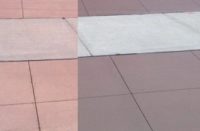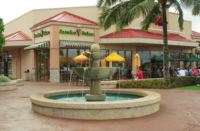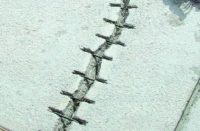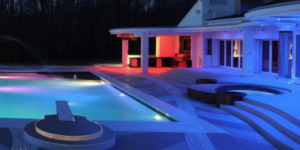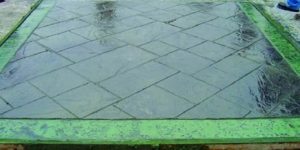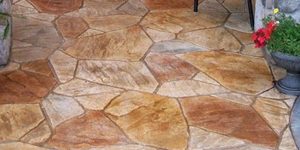
Overland Park, Kansas, a suburb of Kansas City, often makes it onto lists of the nation’s most livable cities. But for a slab of concrete, Overland Park is a bad place to be.
“Concrete gets pretty abused with our climate here,” says Mike Denny, president of Artistic Concrete Surfaces, in nearby Olathe, Kansas. “With our freeze-thaw conditions, it’s pretty extreme. Concrete is better off in a northern climate where they get one freeze and it stays frozen all winter. Here we sometimes get two freeze-thaw cycles a day. That’s really what’s hard on concrete.”
The elements had cracked and spalled the 20-year-old concrete pool deck at Cambridge Square Apartments in Overland Park. In the spring of 2013, the complex owners approached ACS about fixing it. They asked ACS to give them a price on repairing the damaged areas, with a plan to tear out the whole slab later and replace it with broom-finished concrete.

Instead, Denny drafted a plan to fix the cracks, patch damage, tear out and replace a few highly deteriorated sections, and then recoat the whole thing with a polymer-modified cement-based topping.
To fix the cracks, ACS used Concrete Staples from Concrete Product Resource, a technology new to ACS at the time. Workers chased the cracks with a saw and cleaned them thoroughly. Then, every 18 inches, they sawed a foot-long cut across each crack, drilled holes at either end of the cut, filled the cut with epoxy, and dropped in a staple. More epoxy went into the crack on top of the staple.
Denny is pleased with the stapling technique. “None of the cracks we did it on have come back,” he says. “It’s pretty amazing.”
Installers used a scarifier to knock off loose material in areas that were spalled, then power-washed to create a porous surface to which the new finish would adhere.
The new finish was CSI Microtopping HD, from ChemSystems Inc. The vinyl-polymer-modified cement-based topping was applied in two coats. First, a base coat was applied with MagicTrowels. “It was really hot and a big, open, windy area,” Denny says. “We had to work in the early mornings and evenings to get it to dry properly.” For this reason, the base coat was applied in four 2,500-square-foot sections.

“Then we came back and put a second coat on with a spray gun and then used a MagicTrowel again to knock down that texture,” Denny says. For the second coat, all 10,000 square feet were done at once with a bigger crew.
For a pool deck, a knockdown texture provides traction and also cools the surface. “When wind passes across it, it has more surface area to cool off the concrete,” Denny says. The bumps also provide little pockets of shade that help cool the surface. (For more about how texture keeps concrete cool, see “Cool Concrete,” Concrete Decor, July 2011.)
The microtopping was applied in its natural white color on the deck. On the coping, it was colored gray at a paint store with Sherwin-Williams pigments.
“It’s the same pigment they add to their paints,” Denny says. “With the overlay material being a white base, I simply asked them to add pigment to my microtopping liquid catalyst as they would to a 5-gallon bucket of water-based acrylic paint. It takes a lot of explaining and phone calls to Sherwin-Williams headquarters for everyone to make sure this is a doable request, but once you have everyone on board, it allows the customer to pick from a large variety of color. You just have to be careful to set the expectations of slight color variance.”
Project at a Glance
Client: Cambridge Square Apartments, Fogelman Management Group
Decorative concrete contractor: Artistic Concrete Surfaces, Olathe, Kansas | www.kansascityconcrete.com
Scope of project: A cracked and spalled pool deck was restored with concrete stapling and a microtopping.
Most challenging aspect: Hot weather accelerated curing of the microtopping, so the project was completed in sections.
Products used: Concrete staples from Concrete Product Resource, CSI Microtopping HD from ChemSystems Inc., pigments from Sherwin-Williams, MagicTrowel from TexMaster Tools
